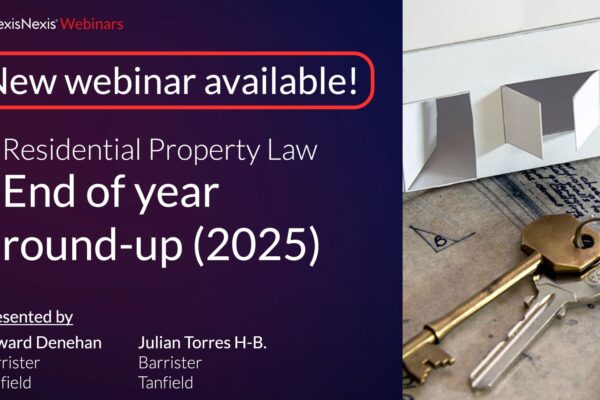Philip Rainey KC and Rhys Duncan examine the Court of Appeal's decision
A practical guide to dealing with the deceased in possession claims

Annie Higgo discusses the types of claims and issues that may arise for property litigators when dealing with deceased parties in the context of possession proceedings.
Introduction
More than one property litigator will have broken out in a cold sweat when they realise that their perfectly prepared possession claim has been derailed by a party, unbeknownst to anyone, having ceased to be alive. This article will discuss some of the procedural and practical points that can arise when deceased parties crop up in possession claims both in the landlord/tenant sphere and in the real property context.
Procedural points regarding deceased claimants and defendants
There are a number of procedural issues that need to be considered from the outset when one of the parties to a possession claim is dead.
When acting for a claimant or person with an interest in a claim who subsequently dies, it is important to consider whether the deceased left a will or if they died intestate. If the deceased left a will, the property vests in their executors from the date of death, so there an executor may bring a claim before probate has been granted, although the position is that until probate is granted they can’t prove title and therefore, unless they themselves have been dispossessed (i.e. the executors took possession on death and then a trespasser has broken in), they can’t get an order for possession. So in practice the best bet may well be to adjourn pending probate (or wait to issue pending probate).
If a person died intestate, property only vests in the administrators from the date of the grant of letters of administration, so there will be a lag before any possession claims can be brought by administrators.
The court also has the power under CPR r19.12(1) to order that a person be appointed to represent the estate of a claimant in circumstances where there are no formally appointed personal representatives (provided the proceedings were not a nullity at the outset – which they would be if as in Millburn-Snell v Evans [2011] EWCA Civ 577 the proceedings were brought on behalf of an intestate’s estate but without a grant of administration), or to order that the claim proceeds in the absence of a representative, though this latter order is not common.
Where a defendant against whom a claim could have been brought dies, if a grant of probate has been made or letters of administration have been granted, the claim must be brought against those personal representatives. If there has been no grant of probate or letters of administration, the claim needs to be brought against “the estate of” the deceased, and the claimant must also make an application under CPR 19.12(2)(b)(ii) to appoint a person to represent the estate of the deceased in the claim. Whether a grant has been made can be checked on the Probate Registry, and parties can also initiate a standing search, which lasts for six months and allows parties to be automatically sent a copy of any grant of representation that is issued within the standing search period.
In preparing applications to appoint a representative under CPR 19.12, sometimes it will be obvious where a person would be suitable to represent the estate, such as a spouse or other close living relative who would be entitled to apply for letters of administration in any event. In other situations, it may not be obvious who ought to be appointed, in which case traces should be carried out to determine whether there are any relatives or other persons within the jurisdiction that might have an interest in the claim and be a suitable appointee. An application to appoint a representative under CPR 19.12 can usefully be supported by a witness statement explaining the suitability of the party nominated to represent the estate of the deceased and their connection, though CPR 19.12 does not formally require the application to be supported by evidence.
Becoming a representative of the estate is purely for the purposes of the claim and does not confer any more general rights or obligations on that representative. Mr Justice Richard Smith said in Bourlakova v Bourlakov [2024] EWHC 1937 (Ch) that the responsibilities were analogous to those of a litigation friend (at paragraph 27). In that case, it was also explained that, in circumstances where there is a dispute over the identity of the persons who are entitled to benefit from and administer an estate, the best person to appoint may well be an independent professional, who can act in the best interests of the estate (at paragraph 5). Similarly, if there is no lay person that can be found who can represent the estate, an independent, professional representative may be an option, however, thought needs to be given as to how that person will be remunerated.
Bringing the tenancy to an end where the tenant has died
A common misconception that often arises relates to the status of the tenancy upon the death of a tenant. The death of a tenant does not determine the tenancy (sections 1 and 3(1) of the Administration of Estates Act 1925), nor does the death of a landlord determine a tenancy. Therefore, to avoid falling foul of an unlawful eviction, landlords must take formal steps to end a tenancy where a tenant has died, rather than simply taking back possession.
Under section 17(1) of the Housing Act 1988 (HA 1988), where the sole tenant under an assured periodic tenancy dies, and immediately prior to their death their spouse or civil partner (or a person who was living with the tenant as if they were a married couple or civil partners) was occupying the dwelling house with the tenant as their only or principal home, then, on the death of the tenant, the assured periodic tenancy automatically vests in the spouse or civil partner. There are also wider statutory succession provisions in the subparagraphs of section 17 in relation to tenancies granted by registered providers of social housing, and a tenancy may also potentially devolve under a will.
Where there is no person to succeed to a tenancy, a tenancy previously held by a deceased person can be determined by notice to quit (”NTQ”). If the tenant has executors or administrators, the NTQ should be addressed to and served on those representatives. If there are no executors and no grant of administration has been made, the property vests in the Public Trustee, and the notice should therefore be addressed to “the personal representatives of the deceased” (naming them) and left at or sent by post to the last known place of residence or business of the tenant (which will normally be the property in question), and a copy of it, similarly addressed, should be served on the Public Trustee (section 18(1), Law of Property (Miscellaneous Provisions) Act 1994). The NTQ must be served on the Public Trustee before the period of notice in the NTQ expires (Gateway Housing v Ali [2020] EWCA Civ 1339).
When serving a copy of the NTQ on the Public Trustee, it should be accompanied by a completed Form NL(1). The Public Trustee will acknowledge receipt of the notice and will file the notice against the name of the deceased against the register it maintains. It would be advisable not to bring a possession claim against a deceased tenant until a letter of acknowledgment has been received from the Public Trustee or the claimant can otherwise provide evidence that the notice has been registered.
A landlord under a periodic assured tenancy can also serve notice under section 8 of the HA 1988, relying on Ground 7 in Schedule 2 to that act. The notice period required under this Ground is two months. In practice, an NTQ is often the more straightforward manner in which to terminate a tenancy which has ceased to be assured due to the death of the tenant, and ground 7 is suited to case when a tenancy has devolved under a will to a person or been assented to them by the personal representatives, and the tenancy has therefore continued to be assured.
Possible claims arising from the death of property owners
Possession claims can also arise outside of the landlord and tenant context, which are complicated by the death of the property owner. Often, cases arise where a person has been living as a bare licensee with a property owner, the property owner subsequently dies, and the personal representatives then attempt to serve a notice to quit on the licensee to determine their right to occupy. Counterclaims for proprietary estoppel, constructive trusts or claims under the Inheritance (Provision for Family and Dependants) Act 1975 (1975 Act) frequently then arise in this context, and what began as a straightforward possession claim spirals into an expensive multitrack trial.
From an advisory perspective, practitioners should be conscious of the potential of such claims to arise and for any license arrangements to be formalised, and for property owners to formally record the nature of different parties’ interests in property. Whilst there are obvious evidential hurdles for parties trying to assert an interest in a property that varies from the legal ownership, these avenues can be narrowed if the property owner formally records the ownership of property in an express trust deed.
From an evidential perspective, once litigation is on foot, one of the key aspects in proving any alleged resulting or constructive trust will be bank statements and evidence of financial contributions to the purchase of the property, the mortgage, and expenditure on the property generally. This is likely to be onerous for both parties, so whichever side you are representing, getting on top of the financial evidence early can be a useful way to cut through the issues and potentially bring about a settlement if it is obvious that one party simply cannot substantiate any claims. Additionally, this sort of financial information is vital to any claim under the 1975 Act in showing the level of dependence by a person claiming under that Act, and by preparing a budget to justify any award for the dependant’s maintenance, be it reasonable or otherwise.
Claims under the 1975 Act are a useful tool for property litigators to be aware of when dealing with possession claims. They are something that should be thought about when a property owner has died where those continuing to be resident in the property have not been provided for under the deceased’s will (or have been inadequately provided for) or are not provided for in an intestacy, and fall within one of the categories of permitted applicants set out in the Act itself. Whilst claims under the 1975 Act often concern financial provision, the court’s powers under the statute are incredibly wide, and awards for “maintenance” have included the transfer of a property outright, or the grant of a life interest, a number of which have been upheld on appeal.
It is key to remember regarding a claim under the 1975 Act that there is a six-month time limit from the date of the grant of probate or letters of administration. Whilst parties can enter into standstill agreements, the court still needs to give permission to applicants to bring a claim under the 1975 Act after this time limit has expired.
Whilst previous case law is beneficial, fundamentally, claims to an interest in property as a defence to possession claims will turn on the evidence. Therefore, alongside financial evidence, when acting for the defendants in such claims, it is worthwhile asking clients to accumulate evidence early to assist with pleading out the strongest possible case for an interest arising under a trust. From a practitioner’s perspective, drafting a defence with bare instructions and nothing to substantiate the claim for an interest often feels like fighting a losing battle. This is particularly so given that the burden of proof falls on the party seeking to assert that the register does not properly reflect the parties’ beneficial interests in the property.
Conclusion
There are specific considerations that need to be borne in mind when dealing with deceased parties in a possession context. Getting the fundamental procedural and legal points correct is vital to give a possession claim the best chance of succeeding at the first hearing and avoiding procedural adjournments, if acting for claimants. On the other hand, being aware of the multitude of equitable and statutory ways in which interests in property can arise where the legal owner has died is a useful tool when acting for defendants who may be facing possession claims.
This article first appeared in Practical Law’s Property Litigation column.
This content is provided free of charge for information purposes only. It does not constitute legal advice and should not be relied on as such. No responsibility for the accuracy and/or correctness of the information and commentary set out in the article, or for any consequences of relying on it, is assumed or accepted by any member of Tanfield or by Tanfield as a whole.

![Service charges, the reasonableness of long-term agreements, and the burden of proof: Spender v FIT Nominee Ltd [2025] EWCA Civ 1578](https://tanfieldchambers.co.uk/wp-content/uploads/2026/01/shutterstock_572046385-600x400.jpg)




